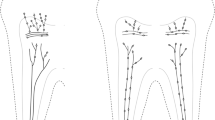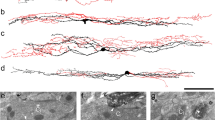Abstract
RECENT studies (for review see ref. 1) have indicated the existence of endogenous opiate-related peptides and opiate receptors in the dorsal horn of the spinal cord and in the trigeminal nucleus caudalis (the caudal-most component of the trigeminal spinal tract nucleus in the brain stem). Both structures have marginal and substantia gelatinosa layers, receive the terminals of Aδ and C nociceptive afferents, and constitute essential components of spinal or trigeminal nociceptive pathways2,3. It has been suggested1,4–7 that endogenous opiate-related peptides located in presynaptic endings play an important part in nociceptive transmission by inhibiting the presynaptic input to neurones in nociceptive pathways; presynaptic inhibition is thought8 to result from primary afferent depolarisation (PAD). It has previously been found that jaw-opening reflex activity9–11 and the responses of trigeminal brain stem neurones10,11 to noxious orofacial stimuli can be suppressed by stimulation of the periaqueductal grey matter (PGM) and that this descending control is at least partially narcotic-related in the cat, as it can often be reversed by administering the opiate antagonist naloxone. Furthermore, the iontophoretic application of the opiate-related peptide enkephalin also depresses the activity of these neurones12,13. If the opiate-related peptides are in fact involved in this suppression at a presynaptic level, then by stimulating PGM and related structures one should be able to produce PAD in nociceptive afferents and then abolish the PAD by naloxone administration. We describe here the first test of this proposition, using the tooth pulp (TP) as the source of nociceptive afferents14,15. We have found that these afferents are subject to PAD which, however, cannot be abolished by naloxone.
This is a preview of subscription content, access via your institution
Access options
Subscribe to this journal
Receive 51 print issues and online access
$199.00 per year
only $3.90 per issue
Buy this article
- Purchase on Springer Link
- Instant access to full article PDF
Prices may be subject to local taxes which are calculated during checkout
Similar content being viewed by others
References
Snyder, S. H. Interdisciplinary Sci. Rev. 3, 46–54 (1978).
Kerr, F. W. L. & Casey, K. L. Neurosci. Res. Prog. Bull. 16, 1–207 (1978).
Dubner, R., Gobel, S. & Price, D. D. in Advances in Pain Research and Therapy, Vol. 1 (eds Bonica, J. J. & Albe-Fessard, D.) 137–148 (Raven, New York, 1976).
LaMotte, C., Pert, C. B. & Snyder, S. H. Brain Res. 112, 407–412 (1976).
Jessell, T. M. & Iverson, L. L. Nature 268, 549–551 (1977).
MacDonald, R. L. & Nelson, P. G. Science 199, 1449–1450 (1978).
Heller, J. M., Simon, E. J., Crain, S. M. & Peterson, E. R. Brain Res. 145, 396–400 (1978).
Burke, R. E. & Rudomin, P. in Handbook of Physiology-The Nervous System, Vol. 1, 877–944 (American Physiology Society, Bethesda, 1977).
Oliveras, J. L., Woda, A., Guilbaud, G. & Besson, J. M. Brain Res. 72, 328–331 (1974).
Sessle, B. J., Dubner, R., Greenwood, L. F. & Lucier, G. E. Can. J. Physiol. Pharmac. 54, 66–69 (1976).
Sessle, B. J., Dubner, R., Hu, J. W. & Lucier, G. E. in Pain in the Trigeminal Area (eds Anderson, D. J. & Matthews, B.) 285–294 (North-Holland, Amsterdam, 1977).
Andersen, R. K., Lund, J. P. & Puil, E. in Pain in the Trigeminal Area (eds Anderson, D. J. & Matthews, B.) 271–284 (North-Holland, Amsterdam, 1977).
Henry, J. L., Hu, J. W., Lucier, G. E. & Sessle, B. J. Pain Abst. 1, 180 (1978).
Anderson, D. J., Hannam, A. G. & Matthews, B. Physiol. Rev. 50, 171–195 (1970).
Sessle, B. J. in Proc. 2nd Wld Congr. Pain (Raven, New York, in the press).
Dubner, R. & Sessle, B. J. Expl Neurol. 30, 223–238 (1971).
Sessle, B. J. & Greenwood, L. F. Brain Res. 117, 211–226 (1976).
Wall, P. D. J. Physiol., Lond., 142, 1–21 (1958).
Darian-Smith, I. Int. Rev. Neurobiol. 9, 301–395 (1966).
Davies, W. R., Scott, D. Jr., Vesterstrom, K. & Vyklicky, L. J. Physiol., Lond., 218, 515–532 (1971).
Mayer, D. J. & Price, D. D. Pain 2, 379–404 (1976).
Liebeskind, J. C. & Paul, L. A. A. Rev. Psychol. 28, 41–60 (1977).
Author information
Authors and Affiliations
Rights and permissions
About this article
Cite this article
Hu, J., DOSTROVSKY, J. & SESSLE, B. Primary afferent depolarisation of tooth pulp afferents is not affected by naloxone. Nature 276, 283–284 (1978). https://doi.org/10.1038/276283a0
Received:
Accepted:
Issue Date:
DOI: https://doi.org/10.1038/276283a0
Comments
By submitting a comment you agree to abide by our Terms and Community Guidelines. If you find something abusive or that does not comply with our terms or guidelines please flag it as inappropriate.



